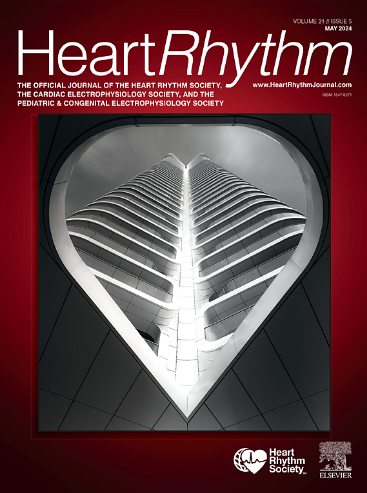Epicardial pacing outcomes in infants with heart block: Lead and device complications from a multicenter experience
IF 5.6
2区 医学
Q1 CARDIAC & CARDIOVASCULAR SYSTEMS
引用次数: 0
Abstract
Background
Infants with complete heart block (CHB) require epicardial pacemaker (PM) insertion. Prior studies described epicardial pacing outcomes in infants and children, although they were limited by small or heterogeneous populations.
Objective
This study aimed to explore patient- and procedure-level associations with device complications in infants with CHB who received a permanent PM.
Methods
This was a multicenter, retrospective cohort study including infants receiving an epicardial PM between 2000 and 2021 for CHB. The primary outcome was time to device-related adverse event: lead failure requiring revision; pocket infection; exit block requiring increased pacing output; or lead-related coronary artery compression. Time-to-event analysis was performed by the Kaplan-Meier method with a multivariable Cox proportional hazards model.
Results
There were 174 infants who received an epicardial PM (282 bipolar, 39 unipolar leads) for CHB. Median age and weight at PM were 93.5 days and 4.5 kg, respectively. Pacing indication was postoperative CHB in 63% and congenital CHB in 37%. The median follow-up was 2.1 years. The primary outcome occurred in 26 infants at a median time to event of 0.6 year. Age ≤90 days at PM implantation was the most significant risk factor for a device-related adverse event (hazard ratio, 7.02; P < .001), primarily driven by pocket infections. Lead failure occurred in 3% of leads with a 5- and 10-year freedom from failure of 93% and 83%, respectively.
Conclusion
Device complications affect 15% of infants receiving a permanent PM for heart block. Age ≤90 days at PM implantation is especially associated with infectious complications. Epicardial lead durability appears similar to previously reported pediatric experiences.
心脏传导阻滞婴儿的心外膜起搏结果:多中心经验中的导联和设备并发症
背景:患有完全性心脏传导阻滞(CHB)的婴儿需要植入心外膜起搏器(PM)。之前的研究描述了婴儿和儿童心外膜起搏的结果,但受限于小规模和/或异质性人群:目的:探讨接受永久性 PM 的 CHB 婴儿患者和手术级别与设备并发症的关联:多中心、回顾性队列研究,包括2000-2021年间因CHB接受心外膜永久性心肌梗死的婴儿。主要结果是发生与设备相关的不良事件(DRAE)的时间:(1) 导联失效,需要修改;(2) 袋感染;(3) 出口阻滞,需要增加起搏输出;或 (4) 与导联相关的冠状动脉压迫。采用卡普兰-梅耶法和多变量考克斯比例危险模型对事件发生时间进行分析:174名婴儿因CHB接受了心外膜 PM(282个双极导联,39个单极导联)。接受 PM 时的中位年龄和体重分别为 93.5 天和 4.5 千克。起搏指征为术后CHB的占63%,先天性CHB的占37%。中位随访时间为 2.1 年。主要结果发生在 26 名婴儿身上,中位发生时间为 0.6 年。PM 时年龄小于 90 天是 DRAE 最重要的风险因素(HR 7.02,p 结论:15%因心脏传导阻滞而接受永久性 PM 的婴儿会出现设备并发症。植入永久性心导管时年龄≤90 天的婴儿尤其容易出现感染性并发症。心外膜导联耐久性与之前报道的儿科经验相似。
本文章由计算机程序翻译,如有差异,请以英文原文为准。
求助全文
约1分钟内获得全文
求助全文
来源期刊

Heart rhythm
医学-心血管系统
CiteScore
10.50
自引率
5.50%
发文量
1465
审稿时长
24 days
期刊介绍:
HeartRhythm, the official Journal of the Heart Rhythm Society and the Cardiac Electrophysiology Society, is a unique journal for fundamental discovery and clinical applicability.
HeartRhythm integrates the entire cardiac electrophysiology (EP) community from basic and clinical academic researchers, private practitioners, engineers, allied professionals, industry, and trainees, all of whom are vital and interdependent members of our EP community.
The Heart Rhythm Society is the international leader in science, education, and advocacy for cardiac arrhythmia professionals and patients, and the primary information resource on heart rhythm disorders. Its mission is to improve the care of patients by promoting research, education, and optimal health care policies and standards.
 求助内容:
求助内容: 应助结果提醒方式:
应助结果提醒方式:


